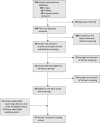A Scoping Review of Economic Evaluations of Workplace Wellness Programs
- PMID: 33541206
- PMCID: PMC8579389
- DOI: 10.1177/0033354920976557
A Scoping Review of Economic Evaluations of Workplace Wellness Programs
Abstract
Objective: Debates about the effectiveness of workplace wellness programs (WWPs) call for a review of the evidence for return on investment (ROI) of WWPs. We examined literature on the heterogeneity in methods used in the ROI of WWPs to show how this heterogeneity may affect conclusions and inferences about ROI.
Methods: We conducted a scoping review using systematic review methods and adhered to the Preferred Reporting Items for Systematic Reviews and Meta-Analyses guidelines. We reviewed PubMed, EconLit, Proquest Central, and Scopus databases for published articles. We included articles that (1) were published before December 20, 2019, when our last search was conducted, and (2) met our inclusion criteria that were based on target population, target intervention, evaluation method, and ROI as the main outcome.
Results: We identified 47 peer-reviewed articles from the selected databases that met our inclusion criteria. We explored the effect of study characteristics on ROI estimates. Thirty-one articles had ROI measures. Studies with costs of presenteeism had the lowest ROI estimates compared with other cost combinations associated with health care and absenteeism. Studies with components of disease management produced higher ROI than programs with components of wellness. We found a positive relationship between ROI and program length and a negative relationship between ROI and conflict of interest. Evaluations in small companies (≤500 employees) were associated with lower ROI estimates than evaluations in large companies (>500 employees). Studies with lower reporting quality scores, including studies that were missing information on statistical inference, had lower ROI estimates. Higher methodologic quality was associated with lower ROI estimates.
Conclusion: This review provides recommendations that can improve the methodologic quality of studies to validate the ROI and public health effects of WWPs.
Keywords: return on investment; systematic review; workplace wellness; workplace wellness programs.
Conflict of interest statement
Figures
Similar articles
-
Return on Investment of Workplace Wellness: Evidence From a Long-Term Care Company.Workplace Health Saf. 2021 Feb;69(2):81-90. doi: 10.1177/2165079920953052. Epub 2020 Sep 23. Workplace Health Saf. 2021. PMID: 32967587
-
The relationship between return on investment and quality of study methodology in workplace health promotion programs.Am J Health Promot. 2014 Jul-Aug;28(6):347-63. doi: 10.4278/ajhp.130731-LIT-395. Am J Health Promot. 2014. PMID: 24977496 Review.
-
A Systematic Review of Productivity in Economic Evaluations of Workplace Interventions: A Need for Reporting Criteria?Appl Health Econ Health Policy. 2019 Oct;17(5):591-613. doi: 10.1007/s40258-019-00473-8. Appl Health Econ Health Policy. 2019. PMID: 30937837
-
Return on Investment: Evaluating the Evidence Regarding Financial Outcomes of Workplace Wellness Programs.J Nurs Adm. 2017 Jul/Aug;47(7-8):379-383. doi: 10.1097/NNA.0000000000000499. J Nurs Adm. 2017. PMID: 28727623 Review.
-
Beyond the black stump: rapid reviews of health research issues affecting regional, rural and remote Australia.Med J Aust. 2020 Dec;213 Suppl 11:S3-S32.e1. doi: 10.5694/mja2.50881. Med J Aust. 2020. PMID: 33314144
Cited by
-
Increased dietary fiber is associated with weight loss among Full Plate Living program participants.Front Nutr. 2023 Apr 17;10:1110748. doi: 10.3389/fnut.2023.1110748. eCollection 2023. Front Nutr. 2023. PMID: 37139446 Free PMC article.
-
A scoping review of digital workplace wellness interventions in low- and middle-income countries.PLoS One. 2023 Feb 28;18(2):e0282118. doi: 10.1371/journal.pone.0282118. eCollection 2023. PLoS One. 2023. PMID: 36854022 Free PMC article.
-
Short-term economic evaluation of physical activity-based corporate health programs: a systematic review.J Occup Health. 2024 Jan 4;66(1):uiae002. doi: 10.1093/joccuh/uiae002. J Occup Health. 2024. PMID: 38183160 Free PMC article.
References
-
- De Greef M., Van den Broek K. Making the Case for Workplace Health Promotion: Analysis of the Effects of WHP. European Network for Workplace Health Promotion; 2004.
-
- Spence GB. Workplace wellbeing programs: if you build it they may NOT come…because it’s not what they really need! Int J Wellbeing. 2015;5(2):109-124.10.5502/ijw.v5i2.7 - DOI
-
- Jones SRG. Was there a Hawthorne effect? Am J Sociol. 1992;98(3):451-468.10.1086/230046 - DOI
Publication types
MeSH terms
LinkOut - more resources
Full Text Sources
Other Literature Sources
Miscellaneous


